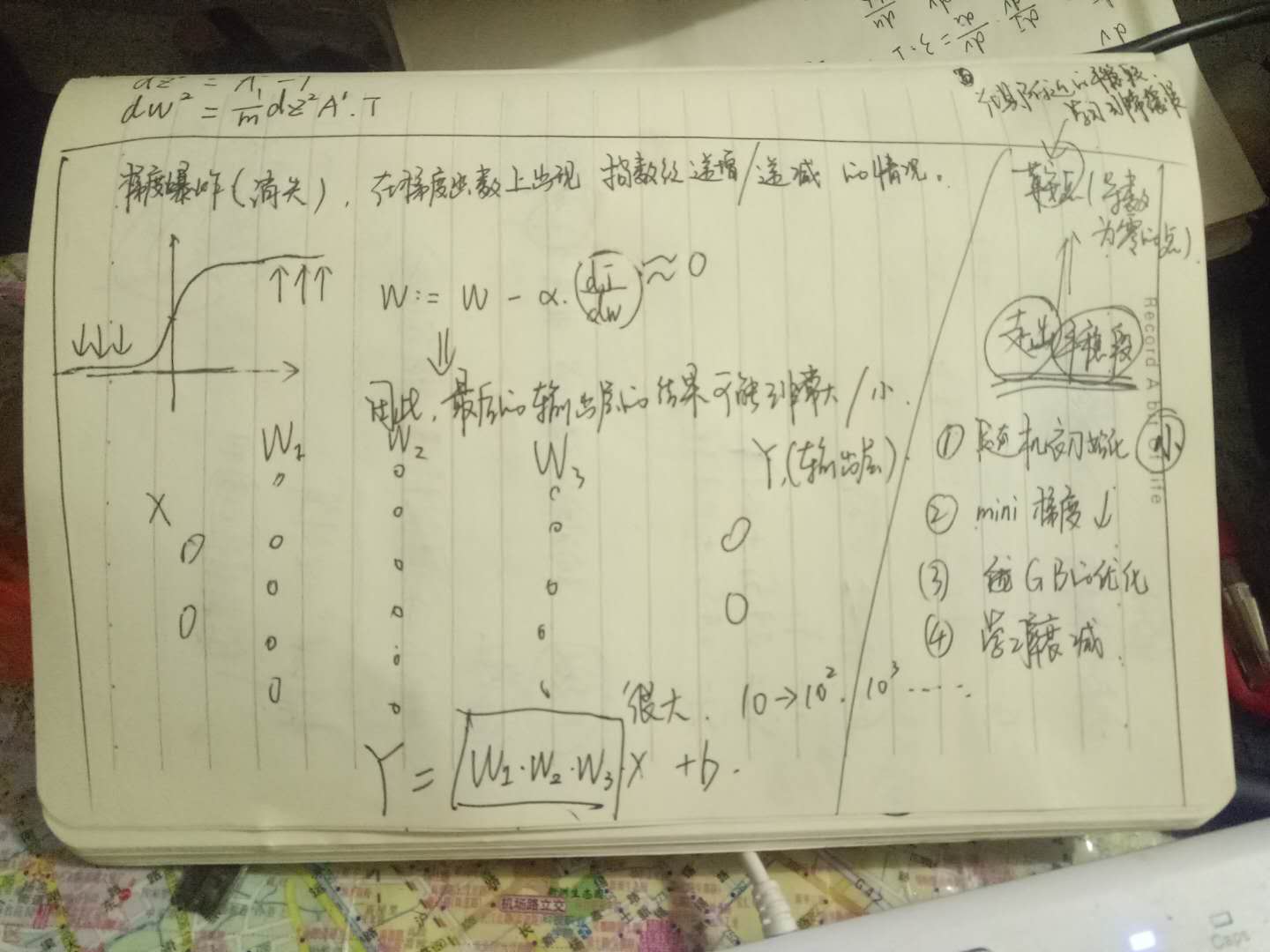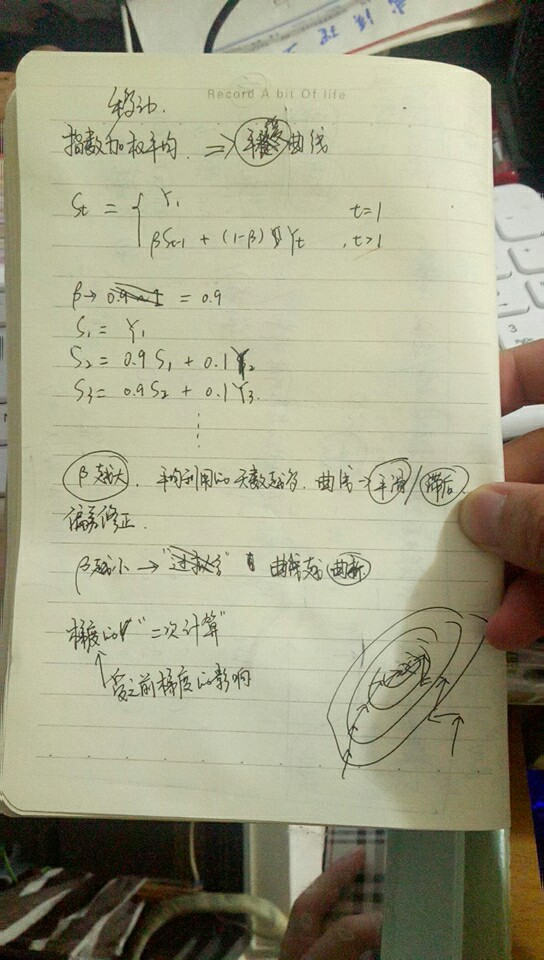梯度下降算法改进笔记




作业:
自己实现动量梯度下降和Adam梯度下降算法
优化算法:
import numpy as np import matplotlib.pyplot as plt import math import sklearn import sklearn.datasets # 前向传播,计算损失,反向传播 from utils import initialize_parameters, forward_propagation, compute_cost, backward_propagation from utils import load_dataset, predict def random_mini_batches(X, Y, mini_batch_size=64, seed=0): """ 创建每批次固定数量特征值和目标值 """ np.random.seed(seed) # 样本数量 m = X.shape[1] mini_batches = [] # 对所有数据进行打乱 permutation = list(np.random.permutation(m)) shuffled_X = X[:, permutation] shuffled_Y = Y[:, permutation].reshape((1, m)) # 循环将每批次数据按照固定格式装进列表当中 num_complete_minibatches = math.floor( m / mini_batch_size) # 所有训练数据分成多少组 for k in range(0, num_complete_minibatches): mini_batch_X = shuffled_X[:, k * mini_batch_size: (k + 1) * mini_batch_size] mini_batch_Y = shuffled_Y[:, k * mini_batch_size: (k + 1) * mini_batch_size] mini_batch = (mini_batch_X, mini_batch_Y) mini_batches.append(mini_batch) # 最后剩下的样本数量mini-batch < mini_batch_size if m % mini_batch_size != 0: mini_batch_X = shuffled_X[:, num_complete_minibatches * mini_batch_size:] mini_batch_Y = shuffled_Y[:, num_complete_minibatches * mini_batch_size:] mini_batch = (mini_batch_X, mini_batch_Y) mini_batches.append(mini_batch) return mini_batches def initialize_momentum(parameters): """ 初始化网络中每一层的动量梯度下降的指数加权平均结果参数 parameters['W' + str(l)] = Wl parameters['b' + str(l)] = bl return: v['dW' + str(l)] = velocity of dWl v['db' + str(l)] = velocity of dbl """ # 得到网络的层数 L = len(parameters) // 2 v = {} # 初始化动量参数 for l in range(L): v["dW" + str(l + 1)] = np.zeros(parameters['W' + str(l + 1)].shape) v["db" + str(l + 1)] = np.zeros(parameters['b' + str(l + 1)].shape) return v def update_parameters_with_momentum(parameters, gradients, v, beta, learning_rate): """ 动量梯度下降算法实现 """ # 得到网络的层数 L = len(parameters) // 2 # 动量梯度参数更新 for l in range(L): # 开始 # 1.计算梯度的指数加权平均数 v["dW" + str(l + 1)] = beta * v["dW" + str(l + 1)] + (1 - beta) * gradients["dW" + str(l + 1)] v["db" + str(l + 1)] = beta * v["db" + str(l + 1)] + (1 - beta) * gradients["db" + str(l + 1)] # 2.利用该值来更新参数 parameters['W' + str(l + 1)] -= learning_rate * v["dW" + str(l + 1)] parameters['b' + str(l + 1)] -= learning_rate * v["db" + str(l + 1)] # 结束 return parameters, v def initialize_adam(parameters): """ 初始化Adam算法中的参数 parameters['W' + str(l)] = Wl parameters['b' + str(l)] = bl return: v['dW' + str(l)] = velocity of v_dWl v['db' + str(l)] = velocity of v_dbl s['dw' + str(l)] = velocity of s_dwl s['db' + str(l)] = velocity of s_dbl """ # 得到网络的参数 L = len(parameters) // 2 v = {} s = {} # 利用输入,初始化参数v,s for l in range(L): v["dW" + str(l + 1)] = np.zeros(parameters['W' + str(l + 1)].shape) v["db" + str(l + 1)] = np.zeros(parameters['b' + str(l + 1)].shape) s["dW" + str(l + 1)] = np.zeros(parameters['W' + str(l + 1)].shape) s["db" + str(l + 1)] = np.zeros(parameters['b' + str(l + 1)].shape) return v, s def update_parameters_with_adam(parameters, gradients, v, s, t, learning_rate=0.01, beta1=0.9, beta2=0.999, epsilon=1e-8): """ 更新Adam算法网络的参数 """ # 网络大小 L = len(parameters) // 2 v_corrected = {} s_corrected = {} # 更新所有参数 for l in range(L): # 对梯度进行移动平均计算. 输入: "v, gradients, beta1". 输出: "v". # 开始 v["dW" + str(l + 1)] = beta1 * v['dW' + str(l + 1)] + (1 - beta1) * gradients['dW' + str(l + 1)] v["db" + str(l + 1)] = beta1 * v['db' + str(l + 1)] + (1 - beta1) * gradients['db' + str(l + 1)] # 结束 # 计算修正结果. 输入: "v, beta1, t". 输出: "v_corrected". # 开始 v_corrected["dW" + str(l + 1)] = v['dW' + str(l + 1)] / (1 - np.power(beta1, t)) v_corrected["db" + str(l + 1)] = v['db' + str(l + 1)] / (1 - np.power(beta1, t)) # 结束 # 平方梯度的移动平均值. 输入: "s, gradients, beta2". 输出: "s". # 开始 s["dW" + str(l + 1)] = beta2 * s['dW' + str(l + 1)] + (1 - beta2) * np.power(gradients['dW' + str(l + 1)], 2) s["db" + str(l + 1)] = beta2 * s['db' + str(l + 1)] + (1 - beta2) * np.power(gradients['db' + str(l + 1)], 2) # 结束 # 计算修正的结果. 输入: "s, beta2, t". 输出: "s_corrected". # 开始 s_corrected["dW" + str(l + 1)] = s['dW' + str(l + 1)] / (1 - np.power(beta2, t)) s_corrected["db" + str(l + 1)] = s['db' + str(l + 1)] / (1 - np.power(beta2, t)) # 结束 # 更新参数. 输入: "parameters, learning_rate, v_corrected, s_corrected, epsilon". 输出: "parameters". # 开始 parameters["W" + str(l + 1)] = parameters['W' + str(l + 1)] - learning_rate * v_corrected[ 'dW' + str(l + 1)] / np.sqrt(s_corrected['dW' + str(l + 1)] + epsilon) parameters["b" + str(l + 1)] = parameters['b' + str(l + 1)] - learning_rate * v_corrected[ 'db' + str(l + 1)] / np.sqrt(s_corrected['db' + str(l + 1)] + epsilon) # 结束 return parameters, v, s def model(X, Y, optimizer, learning_rate=0.0007, mini_batch_size=64, beta=0.9, beta1=0.9, beta2=0.999, epsilon=1e-8, num_epochs=10000, print_cost=True): """ 模型逻辑 定义一个三层网络(不包括输入层) 第一个隐层:5个神经元 第二个隐层:2个神经元 输出层:1个神经元 """ # 计算网络的层数 layers_dims = [train_X.shape[0], 5, 2, 1] L = len(layers_dims) costs = [] t = 0 seed = 10 # 初始化网络结构 parameters = initialize_parameters(layers_dims) # 初始化优化器参数 if optimizer == "momentum": v = initialize_momentum(parameters) elif optimizer == "adam": v, s = initialize_adam(parameters) # 优化逻辑 for i in range(num_epochs): # 每次迭代所有样本顺序打乱不一样 seed = seed + 1 # 获取每批次数据 minibatches = random_mini_batches(X, Y, mini_batch_size, seed) # print("minibatches到底是啥", minibatches) # mini_batch = (mini_batch_X, mini_batch_Y) # mini_batches.append(mini_batch) # 开始 for minibatch in minibatches: # 1.准备数据(minibatch每批次的数据) mini_batch_X, mini_batch_Y = minibatch # 2.前向传播 a3, cache = forward_propagation(mini_batch_X, parameters) # 3.计算损失 cost = compute_cost(a3, mini_batch_Y) # 4.反向传播,回传损失,返回梯度 gradients = backward_propagation(mini_batch_X, mini_batch_Y, cache) # 5.利用梯度更新参数 if optimizer == "momentum": parameters, v = update_parameters_with_momentum(parameters, gradients, v, beta, learning_rate) elif optimizer == "adam": # todo t = t + 1 parameters, v, s = update_parameters_with_adam(parameters, gradients, v, s, t, learning_rate, beta1, beta2, epsilon) # 结束 # 每个1000批次打印损失 if print_cost and i % 1000 == 0: print("第 %i 次迭代的损失值: %f" % (i, cost)) if print_cost and i % 100 == 0: costs.append(cost) # 画出损失的变化 plt.plot(costs) plt.ylabel('cost') plt.xlabel('epochs (per 100)') plt.title("损失图") plt.show() return parameters if __name__ == '__main__': train_X, train_Y = load_dataset() parameters = model(train_X, train_Y, optimizer="adam") predictions = predict(train_X, train_Y, parameters)
辅助代码(初始化参数+前向传播+计算损失+反向传播(计算梯度)+进行预测+加载数据集....):
import numpy as np import matplotlib.pyplot as plt import h5py import scipy.io import sklearn import sklearn.datasets def sigmoid(x): """ Compute the sigmoid of x Arguments: x -- A scalar or numpy array of any size. Return: s -- sigmoid(x) """ s = 1/(1+np.exp(-x)) return s def relu(x): """ Compute the relu of x Arguments: x -- A scalar or numpy array of any size. Return: s -- relu(x) """ s = np.maximum(0,x) return s def initialize_parameters(layer_dims): """ Arguments: layer_dims -- python array (list) containing the dimensions of each layer in our network Returns: parameters -- python dictionary containing your parameters "W1", "b1", ..., "WL", "bL": W1 -- weight matrix of shape (layer_dims[l], layer_dims[l-1]) b1 -- bias vector of shape (layer_dims[l], 1) Wl -- weight matrix of shape (layer_dims[l-1], layer_dims[l]) bl -- bias vector of shape (1, layer_dims[l]) Tips: - For example: the layer_dims for the "Planar Data classification model" would have been [2,2,1]. This means W1's shape was (2,2), b1 was (1,2), W2 was (2,1) and b2 was (1,1). Now you have to generalize it! - In the for loop, use parameters['W' + str(l)] to access Wl, where l is the iterative integer. """ np.random.seed(3) parameters = {} L = len(layer_dims) # number of layers in the network for l in range(1, L): parameters['W' + str(l)] = np.random.randn(layer_dims[l], layer_dims[l-1])* np.sqrt(2 / layer_dims[l-1]) parameters['b' + str(l)] = np.zeros((layer_dims[l], 1)) assert(parameters['W' + str(l)].shape == layer_dims[l], layer_dims[l-1]) assert(parameters['W' + str(l)].shape == layer_dims[l], 1) return parameters def compute_cost(a3, Y): """ Implement the cost function Arguments: a3 -- post-activation, output of forward propagation Y -- "true" labels vector, same shape as a3 Returns: cost - value of the cost function """ m = Y.shape[1] logprobs = np.multiply(-np.log(a3),Y) + np.multiply(-np.log(1 - a3), 1 - Y) cost = 1./m * np.sum(logprobs) return cost def forward_propagation(X, parameters): """ Implements the forward propagation (and computes the loss) presented in Figure 2. Arguments: X -- input dataset, of shape (input size, number of examples) parameters -- python dictionary containing your parameters "W1", "b1", "W2", "b2", "W3", "b3": W1 -- weight matrix of shape () b1 -- bias vector of shape () W2 -- weight matrix of shape () b2 -- bias vector of shape () W3 -- weight matrix of shape () b3 -- bias vector of shape () Returns: loss -- the loss function (vanilla logistic loss) """ # retrieve parameters W1 = parameters["W1"] b1 = parameters["b1"] W2 = parameters["W2"] b2 = parameters["b2"] W3 = parameters["W3"] b3 = parameters["b3"] # LINEAR -> RELU -> LINEAR -> RELU -> LINEAR -> SIGMOID z1 = np.dot(W1, X) + b1 a1 = relu(z1) z2 = np.dot(W2, a1) + b2 a2 = relu(z2) z3 = np.dot(W3, a2) + b3 a3 = sigmoid(z3) cache = (z1, a1, W1, b1, z2, a2, W2, b2, z3, a3, W3, b3) return a3, cache def backward_propagation(X, Y, cache): """ Implement the backward propagation presented in figure 2. Arguments: X -- input dataset, of shape (input size, number of examples) Y -- true "label" vector (containing 0 if cat, 1 if non-cat) cache -- cache output from forward_propagation() Returns: gradients -- A dictionary with the gradients with respect to each parameter, activation and pre-activation variables """ m = X.shape[1] (z1, a1, W1, b1, z2, a2, W2, b2, z3, a3, W3, b3) = cache dz3 = 1./m * (a3 - Y) dW3 = np.dot(dz3, a2.T) db3 = np.sum(dz3, axis=1, keepdims = True) da2 = np.dot(W3.T, dz3) dz2 = np.multiply(da2, np.int64(a2 > 0)) dW2 = np.dot(dz2, a1.T) db2 = np.sum(dz2, axis=1, keepdims = True) da1 = np.dot(W2.T, dz2) dz1 = np.multiply(da1, np.int64(a1 > 0)) dW1 = np.dot(dz1, X.T) db1 = np.sum(dz1, axis=1, keepdims = True) gradients = {"dz3": dz3, "dW3": dW3, "db3": db3, "da2": da2, "dz2": dz2, "dW2": dW2, "db2": db2, "da1": da1, "dz1": dz1, "dW1": dW1, "db1": db1} return gradients def predict(X, y, parameters): """ This function is used to predict the results of a n-layer neural network. Arguments: X -- data set of examples you would like to label parameters -- parameters of the trained model Returns: p -- predictions for the given dataset X """ m = X.shape[1] p = np.zeros((1,m), dtype = np.int) # Forward propagation a3, caches = forward_propagation(X, parameters) # convert probas to 0/1 predictions for i in range(0, a3.shape[1]): if a3[0,i] > 0.5: p[0,i] = 1 else: p[0,i] = 0 print("Accuracy: " + str(np.mean((p[0,:] == y[0,:])))) return p def load_dataset(): np.random.seed(3) train_X, train_Y = sklearn.datasets.make_moons(n_samples=300, noise=.2) train_X = train_X.T train_Y = train_Y.reshape((1, train_Y.shape[0])) return train_X, train_Y







【推荐】国内首个AI IDE,深度理解中文开发场景,立即下载体验Trae
【推荐】编程新体验,更懂你的AI,立即体验豆包MarsCode编程助手
【推荐】抖音旗下AI助手豆包,你的智能百科全书,全免费不限次数
【推荐】轻量又高性能的 SSH 工具 IShell:AI 加持,快人一步
· 从 HTTP 原因短语缺失研究 HTTP/2 和 HTTP/3 的设计差异
· AI与.NET技术实操系列:向量存储与相似性搜索在 .NET 中的实现
· 基于Microsoft.Extensions.AI核心库实现RAG应用
· Linux系列:如何用heaptrack跟踪.NET程序的非托管内存泄露
· 开发者必知的日志记录最佳实践
· winform 绘制太阳,地球,月球 运作规律
· AI与.NET技术实操系列(五):向量存储与相似性搜索在 .NET 中的实现
· 超详细:普通电脑也行Windows部署deepseek R1训练数据并当服务器共享给他人
· 【硬核科普】Trae如何「偷看」你的代码?零基础破解AI编程运行原理
· 上周热点回顾(3.3-3.9)